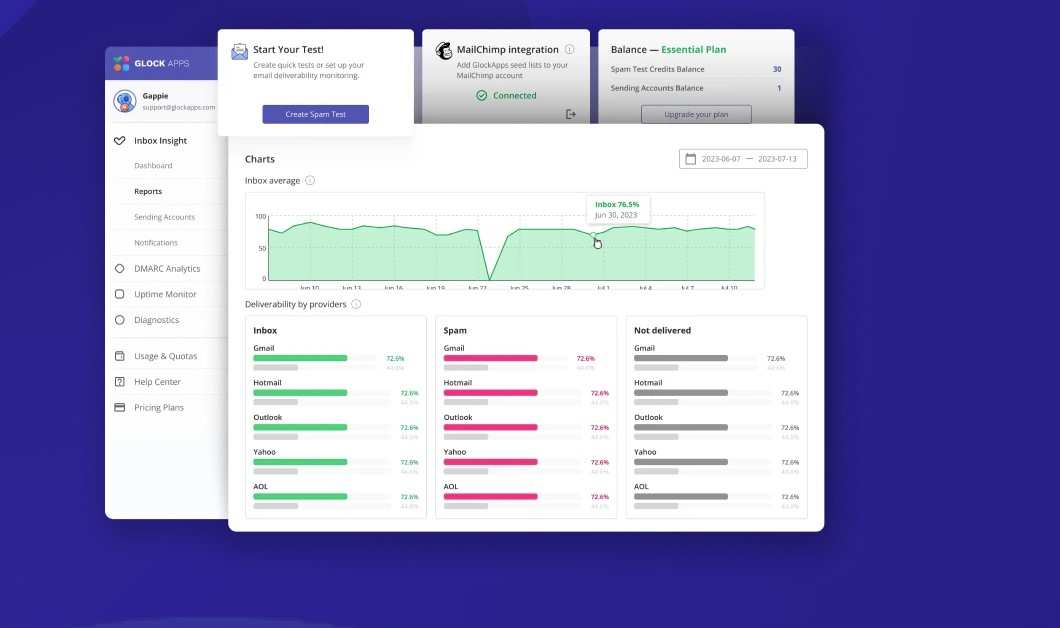All your emails regarding new launches, discounted offers, and your sheer existence will go in vain if the person you sent it won’t see it. Your mail must land in the right spot where recipients can open it without much effort. The core value of your email deliverability stems from your mail reaching inboxes or spam folders. Understand Email Deliverability in depth in this article.

Contents
Overview of Email Deliverability
Email deliverability is a term used to refer to the quantity of mail that successfully reaches where it is intended. Generally, emails that get delivered to the subscriber’s inbox mean that your deliverability is on the positive side. If your emails have reached the junk folders or spam of the recipient, then you have poor email deliverability.
Getting high or positive email deliverability is the goal of every email campaign. Such campaigns rely on inbox providers like Gmail and Hotmail for their deliverability. If your choice of inbox providers and your email aligns with the protocols, your mail will reach the right place in the recipient’s inbox. Top-level services offer tools to test email deliverability of your emails so that you can learn more about your campaigns.

How Does Email Deliverability Work?
Your email starts its journey through several checkpoints as soon as you click “send.” Emails are sent by the sender’s server, but they have to pass through gateways and spam filters, which are like watchdogs watching over the recipient’s mail server.
These filters carefully assess the email on several levels, carefully examining things like the legitimacy of the sender, the content’s authenticity, and the sending domain’s reputation. When your email successfully makes it past these strict requirements, it triumphantly lands on the recipient’s server and appears in the promotion tab (for Gmail users) or inbox. Regretfully, not every email gets through without problems. Many run into difficulties, which cause the recipient’s server to reject them or relegate them to the spam folder.
Essentially, sender credibility, content authenticity, and domain trustworthiness all play a delicate balance in email deliverability. If you can successfully handle these components, your emails will overcome the obstacles and arrive at the desired location, which is the recipient’s inbox.

Why do you need Email Deliverability?
Everyone receives emails on a daily basis and it is hard to stand out among the behemoth of emails that your potential customer receives. It’s not guaranteed that the mail about exciting discounts that you sent will reach the inbox of your target audience. To ensure a better reach of your mail, you need email deliverability. Sending emails to your recipient’s main inbox is the starting point of your campaign. After that, they will open it and click on the links inside your email. However, if your mail did not reach the right place then you are bound to lose customers.

According to research, only about 79% of emails enter the inbox of the target audience. The rest goes either in the spam or other unimportant folders. For marketers, these numbers are almost scary, and resorting to good email deliverability is a good investment. To know how much of your mail, platforms like Glock apps offer a spam tester that provides insights about your mail and action steps that you can take to enhance your email deliverability.
How much should be your Email deliverability rate?
It’s difficult to pinpoint the ideal email deliverability rate, but for successful marketing campaigns, a range of 85% to 95% is the sweet spot. However, the optimal rate varies because every business is different. It’s critical to investigate industry benchmarks in order to determine the appropriate metric. A comprehensive picture can be obtained by evaluating the performance of your rivals and your present email inbox placement rate in addition to associated metrics like engagement rates. With this strategy, companies can pinpoint areas that need work, guaranteeing not only high deliverability but also improved outcomes in the ever-changing world of email marketing.
When it comes to marketing emails, most industries consider an open rate of more than 30% to be commendable, as engagement levels are typically low at 20–25%. It is possible to achieve a strong 5–10% increase in open rates by using an email warm-up service. On the other hand, transactional emails have a different experience, frequently achieving 80–85% open rates and deliverability. Testing transactional emails is still worthwhile even with their high open rates because ongoing optimization efforts can produce even better results and improve the communication plan.

Conclusion
Maintaining a good deliverability of emails is a constant work but with the assistance of relevant tools, the burden of work is lower. Whether it is poor list hygiene or changing domains that keep you away from generating significant customers, you need healthy Email deliverability in all aspects of email marketing.



